Frog and Toad Behavior and Life History


| These are pictures and videos that illustrate some of the interesting interesting behavior and or natural history of frogs and toads from California and around the world. This is not an attempt to illustrate everything, only what is depicted elsewhere on this website. Follow the links on the name of each species to find more pictures and information about it. |
||
| The Life Cycle of the California Toad | ||
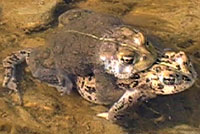 |
||
| This short video shows the life cycle of the California Toad, from the late winter breeding season when frenzied males call and compete and pair up with females who lay long strings of eggs, to tiny black tadpoles just emerged from the eggs then developing and forming huge feeding masses, to the tiny toads, recently-transformed from tadpoles, massing together around the pond edge then dispersing on their own, to an adult toad moving about on its own, as it will remain until the next breeding season. To see more video of each stage, from breeding, to eggs, to tadpoles, to metamorphs, to adult phase, click on the thumbnails below. |
||
 |
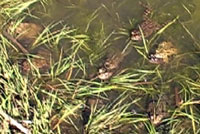 |
 |
 |
 |
 |
 |
 |
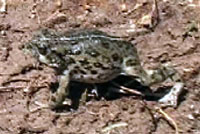 |
| Miscellaneous Frog and Toad Observations | ||
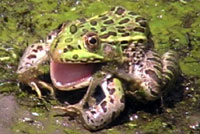 |
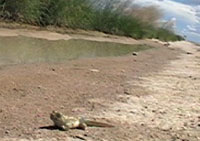 |
 |
| Frogs shed their skin just like snakes and lizards. In this short video you can see the skin pulled from the front toes and rear legs of a Chiricahua Leopard Frog and swallowed. The frog uses all four of its legs to pull the old skin off and push it towards its mouth. The mouth is opened and closed to pull the skin into the mouth. This one minute video was cut down from about five minutes, but the shedding took much longer. | Spadefoot tadpoles hatched in shallow rain pools need to grow and transform quickly when there is no rain and the pools evaporate. Here you can see tadpoles in the water, recently-metamorphosed tailed juveniles on the land and in the water, and some views of a shallow rain pool as it dries up. | Spadefoots spend most of their lives buried in mud or sand. This short video shows a Great Basin Spadefoot digging into sandy soil and burying itself. © Julie Nelson |
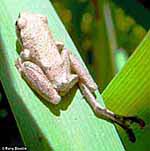 |
 |
 |
| This juvenile treefrog from San Mateo County has a deformed fifth leg. © Rory Doolin. Because of their thin permeable skin, amphibians are one of the first indicators of environmental disturbances, some of which can cause malformations. Learn more about frog deformities here. |
Cascades Frogs live high in the mountains and have a high tolerance for cold. They emerge from hibernation and breed as the snow and ice is melting. This frog is sitting at the edge of the ice covering a mountain pond, while other frogs call and breed nearby. | Toad in the Hole |
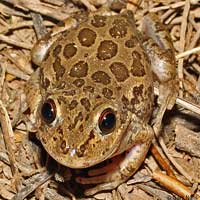 |
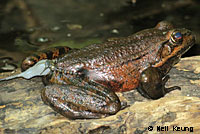 |
|
| The Lowland Burrowing Treefrog lives in the desert, emerging from underground with the summer rain to breed and feed before going back underground. In order to survive during times of drought when moisture underground is scarce, this frog forms a cocoon around its body made of several layers of outer skin, which forms a barrier to keep its body moisture from evaporating. When the rains come again, the frog breaks free of the skin, sheds it, and eats it, not wasting any source of nourishment. | This adult California Red-legged Frog has a transmitter attached to its waist. After it is released, the frog can be found later by using an antenna with a radio receiver that can track the transmitter. This way the frog's movement and behavior can be studied for part of the year. Mature frogs use fat stored in their thighs to produce gametes as the breeding season nears. When the thighs have been significantly reduced in size, the transmitters will slip off the frogs. © Neil Keung Research covered under Federal permits and State Parks permits. |
|
 |
 |
|
| It's a hard life for amphibians in the desert where water needed for egg-laying is scarce. These Red-spotted Toad tadpoles were stranded in evaporating water from an overflowing pond in a spring-fed desert oasis. The small black patch at the bottom of the picture on the left is the same group of tadpoles shown close-up in the picture on the right. Most of these tadpoles were still alive, so the water had only recently dried up and stranded them, most likely dooming them to desiccation. Maybe the tadpoles hatched in the pond and were forced out when it overflowed, or perhaps some eggs were laid in shallow pools of water outside the pond which evaporated before the tadpoles could transform into toads. | ||
| Nictitating Membrane Covering Eyes | ||
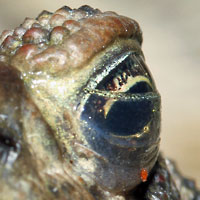 |
 |
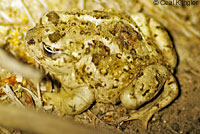 |
| A CanadianToad with the nictitating membrane on its eye partially closed | A Green Frog showing a partially-closed nictitating membrane. | This Great Basin Spadefoot is using its nictitating membrane, a translucent membrane, also called a third eyelid, to moisten its eye. © Ceal Klingler |
| Sexual Dimorphism | ||
Animals that are sexually dimorphic are those where the males differ from the females in appearance. Some species have minor differences in body size that are not immediately observable in the field, but others have differences in color or pattern or in the size of the tympanum, which can let you easily determine the sex by sight. |
||
 |
 |
 |
| An adult female Yosemite Toad (left) has heavy dark blotches on a light background, while an adult male (right) is pale yellowish green or olive above, with few or no dark blotches. | The tympanum (the circle behind the eye) of an male American Bullfrog (left) is much larger than the eye. The tympanum of an adult female (right) is the same size as or smaller than they eye. | |
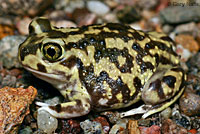 |
 |
 |
| Adult female | Adult male | Adult male (top) and Adult female |
| An adult female Couch's Spadefoot has a heavy pattern of dark markings while and adult male does not. |
||
| Toes and Feet | ||
Some frogs have special pads on their toes that act like suction cups to help them climb steep surfaces, even glass. |
||
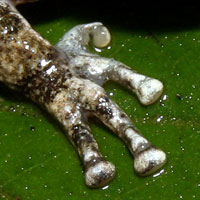 |
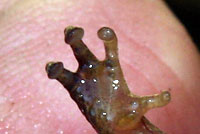 |
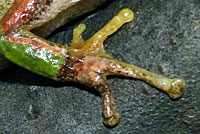 |
| California Treefrog | Baja California Treefrog | Pacific Treefrog |
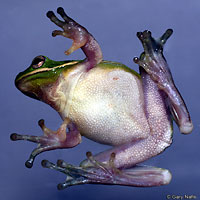 |
 |
 |
| Green Treefrog climbing on class |
Gray Treefrog climbing on glass |
Mexican Treefrog climbing on class |
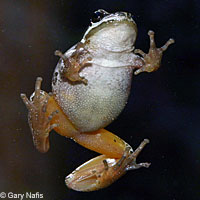 |
||
| Baja California Treefrog climbing on class |
||
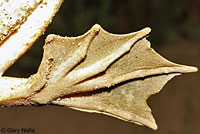 |
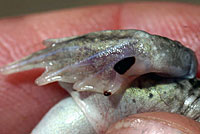 |
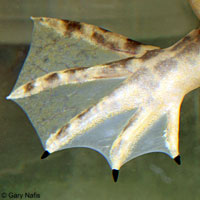 |
| Most frogs, including this American Bullfrog, have large webbed hind feet. | Spadefoots and some toads have hardened spades on the backs of their feet. These spades help them dig underground. This picture shows the small black spade on one of the hind feet of a Great Basin Spadefoot |
The claws on the hind webbed feet of the African Clawed Frog are used to grasp and tear at its food. |
| Aberrant or Unusually-Marked or Colored Frogs and Tadpoles | ||
| Due to unusual skin coloring, markings, skin texture, or other unusual physical features or deformities, these frogs and tadpoles do not look like typical members of their species. |
||
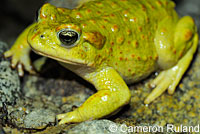 |
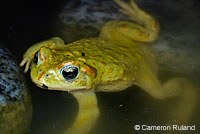 |
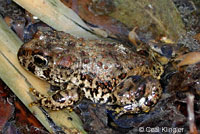 |
| This adult California Toad found in a desert canyon in San Diego County, is missing some of its normal pigmentation, but it's not an albino because the eyes are dark. © Cameron Ruland |
This tiny juvenile toad was found at Darwin Falls, Inyo County, where hybrids with Red-spotted Toads - Bufo punctatus have been found. While it resembles a California Toad, it appears to be a hybrid since it lacks a dorsal stripe and has less oval and more rounded parotoid glands, similar to the Red-spotted Toad. © Ceal Klingler | |
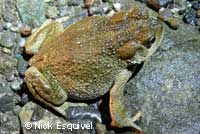 |
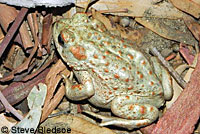 |
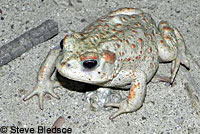 |
| Patternless adult California Toad © Nick Esquivel |
Very pale adult California Toad from a San Diego County Desert valley - looking similar to a Red-spotted Toad. © Steve Bledsoe | |
 |
 |
 |
| Froglet, 10/09/16 | Juvenile frog, 06/23/17 | Juvenile frog, 07/16/17 |
| Three pictures from a series of pictures of a developing leucistic American Bullfrog Tadpole found in Germany. All photos © Michael Waitzmann. See the full series here. |
||
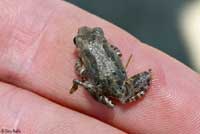 |
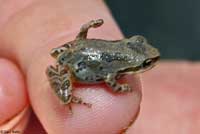 |
 |
| This recently-metamorphosed juvenile Sierran Treefrog from Contra Costa County has a rear leg deformity that is most likely caused by a parasite that is hosted by a snail before it attaches itself to a tadpole. Such deformities are becoming more common and researchers are trying to determine if there are environmental factors which are favoring the parasites or which make the frogs more susceptible to them. |
This juvenile Sierran Treefrog from San Mateo County has a deformed fifth leg. © Rory Doolin. |
|
 |
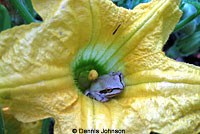 |
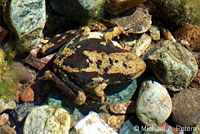 |
| A pink and blue juvenile Sierran Treefrog Yolo County © Lori Grennan |
A blue juvenile Sierran Treefrog found in a squash blossom in El Dorado County © Dennis Johnson |
Adult Foothill Yellow-bellied Frog with a dark mottled pattern, Shasta County © Michael A. Peters |
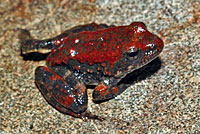 |
 |
 |
| Bright red juvenile Foothill Yellow-bellied Frog from Del Norte County | Two leucistic Cascades Frog tadpoles, © Ryan Aberg |
Cascades Frog tadpoles Bottom/Left: Leucistic Top/Right: Normally-pigmented © Ryan Aberg |
 |
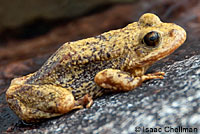 |
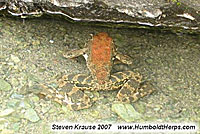 |
| Leucistic adult Pacific Treefrog, Humboldt County © Nathan McCanne | This adult Sierra Nevada Yellow-legged Frog has an unusual pigment condition, possibly leucism or it might be piebald. © Isaac Chellman |
Red-backed form Foothill Yellow-legged Frog, Humboldt County © Steven Krause |
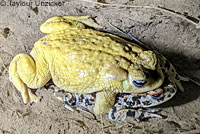 |
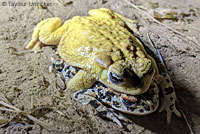 |
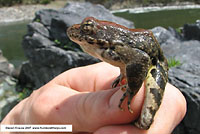 |
| Adult male and female California Toads in amplexus in a San Diego County desert riparian area. The male appears to be leucistic or xanthic. © Taylour Unzicker | Red-backed form Foothill Yellow-legged Frog, Humboldt County © Steven Krause |
|
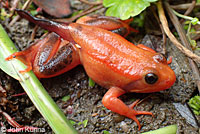 |
 |
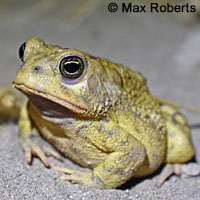 |
| This unusually bright-orange-colored tiny juvenile California Red-Legged Frog has recently gone through metamorphosis, but has not yet lost the remnant of its tail. © John Kunna | Unusually-marked adult Foothill Yellow-legged Frog, Humboldt County © Nathan McCanne |
This abnormally-yellow Rocky Mountain (Woodhouse's) Toad was photographed in Riverside County © Max Roberts |
 |
 |
|
| Melanistic adult American Bullfrog, Santa Clara County © Yuval Helfman | Two melanistic sub-adult American Bullfrogs found in a Butte County pond. © Roxanne Mulder |
|
 |
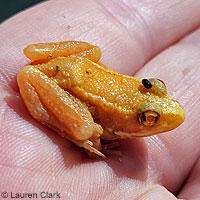 |
 |
| Unusually gray nearly-patternless adult California Red-Legged Frog, Santa Barbara County © Max Roberts | This unusually yellow-orange juvenile Cascades Frog, found at a high-elevation lake in Trinity County, appears to be missing its dark pigment, including the dark pigment normally found in the eyes. © Lauren Clark | |
 |
 |
 |
| This unusually pale American Bullfrog was found in Bakersfield, Kern County. © Jose Casarez |
This very large adult Foothill Yellow-legged Frog appears to be missing dark pigment except in the eyes and it may be erythristic, with an excess of red pigment. © Kong Tran |
|
 |
 |
 |
| These Western Spadefoot tadpoles, including several white ones presumed to be albinos, were observed in a shallow road rut pool in San Diego County. A short time later the albinos were observed to have sprouted legs. © Anicka Kratina-Hathaway | ||
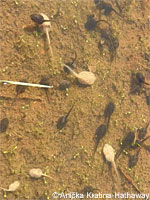 |
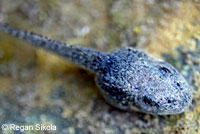 |
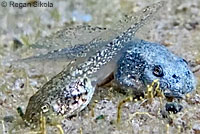 |
| Short Video of the albino Western Spadefoot tadpoles. © Anicka Kratina-Hathaway |
Unusually-pigmented California Treefrog tadpole, Santa Barbara County © Regan Sikola |
Left: typically-pigmented California Treefrog tadpole Right: unusually-pigmented California Treefrog tadpole Santa Barbara County © Regan Sikola |
| Development of a Tadpole Into a Juvenile Frog | ||
| The following series of pictures shows an American Bullfrog tadpole in full metamorphosis - it begins to breathe air, gradually loses its tail, and transforms into a juvenile frog with the body of an adult. Click here to see a larger view |
||
 |
||
| Tadpole without legs, in water, 3 weeks before "Day 1" the first day out of the water. | ||
 |
||
| Tadpole with legs, in water, 1 day before "Day 1" the first day out of the water. | ||
 |
 |
 |
| Metamorph, out of water, Day 1 |
Metamorph, Day 2 | Metamorph, Day 3 |
 |
 |
 |
| Metamorph, Day 4 | Metamorph, Day 5 | Metamorph, Day 6 |
 |
 |
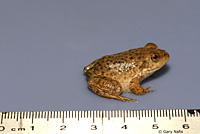 |
| Metamorph, Day 7 | Metamorph, Day 8 | Metamorph, Day 9 |
 |
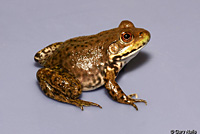 |
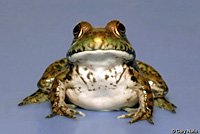 |
| Juvenile, Day 14 | Juvenile, Day 29 | |
Return to the Top
© 2000 -
